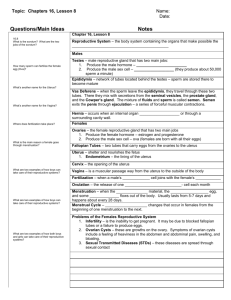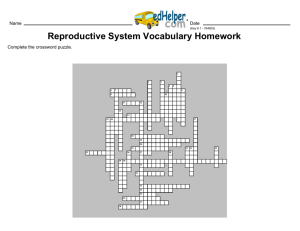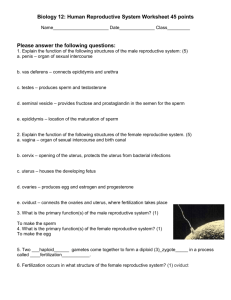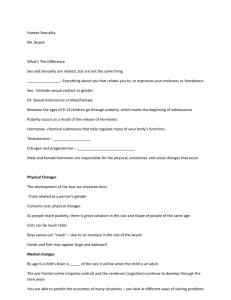CHAPTER 1
advertisement
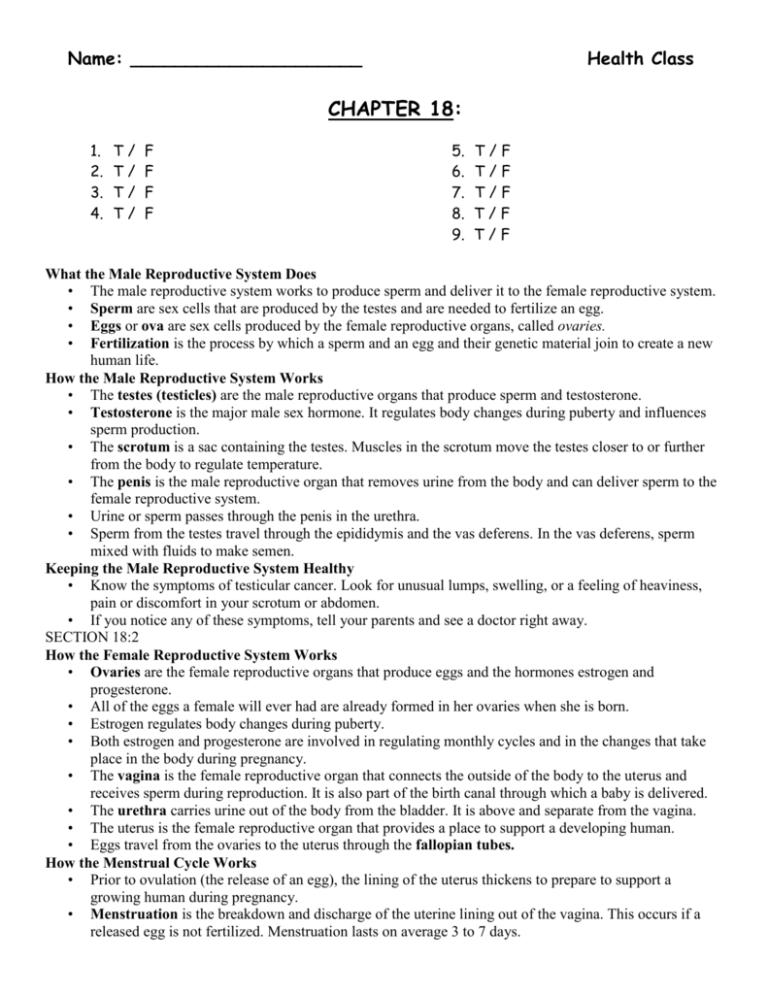
Name: _____________________ Health Class CHAPTER 18: 1. 2. 3. 4. T/ T/ T/ T/ F F F F 5. 6. 7. 8. 9. T/F T/F T/F T/F T/F What the Male Reproductive System Does • The male reproductive system works to produce sperm and deliver it to the female reproductive system. • Sperm are sex cells that are produced by the testes and are needed to fertilize an egg. • Eggs or ova are sex cells produced by the female reproductive organs, called ovaries. • Fertilization is the process by which a sperm and an egg and their genetic material join to create a new human life. How the Male Reproductive System Works • The testes (testicles) are the male reproductive organs that produce sperm and testosterone. • Testosterone is the major male sex hormone. It regulates body changes during puberty and influences sperm production. • The scrotum is a sac containing the testes. Muscles in the scrotum move the testes closer to or further from the body to regulate temperature. • The penis is the male reproductive organ that removes urine from the body and can deliver sperm to the female reproductive system. • Urine or sperm passes through the penis in the urethra. • Sperm from the testes travel through the epididymis and the vas deferens. In the vas deferens, sperm mixed with fluids to make semen. Keeping the Male Reproductive System Healthy • Know the symptoms of testicular cancer. Look for unusual lumps, swelling, or a feeling of heaviness, pain or discomfort in your scrotum or abdomen. • If you notice any of these symptoms, tell your parents and see a doctor right away. SECTION 18:2 How the Female Reproductive System Works • Ovaries are the female reproductive organs that produce eggs and the hormones estrogen and progesterone. • All of the eggs a female will ever had are already formed in her ovaries when she is born. • Estrogen regulates body changes during puberty. • Both estrogen and progesterone are involved in regulating monthly cycles and in the changes that take place in the body during pregnancy. • The vagina is the female reproductive organ that connects the outside of the body to the uterus and receives sperm during reproduction. It is also part of the birth canal through which a baby is delivered. • The urethra carries urine out of the body from the bladder. It is above and separate from the vagina. • The uterus is the female reproductive organ that provides a place to support a developing human. • Eggs travel from the ovaries to the uterus through the fallopian tubes. How the Menstrual Cycle Works • Prior to ovulation (the release of an egg), the lining of the uterus thickens to prepare to support a growing human during pregnancy. • Menstruation is the breakdown and discharge of the uterine lining out of the vagina. This occurs if a released egg is not fertilized. Menstruation lasts on average 3 to 7 days. • The average menstrual cycle lasts 28 days. Ovulation usually occurs on the 14th day. However, this length can vary. Keeping the Female Reproductive System Healthy • Know the signs of breast cancer. Be aware of any unusual lumps in your breasts. • If you detect any lumps, tell your parents and see a doctor right away. SECTION 18:3 • Sexual intercourse is the reproductive process in which the penis is inserted into the vagina and through which a new human life may begin. • From the vagina, sperm travel through the uterus and into the fallopian tubes, where fertilization normally occurs. • After fertilization, the zygote travels to the uterus and embeds in the uterine wall. • The developing human in the first 8 weeks of development is called an embryo. How a Baby Develops • The placenta is an organ that develops in the uterus. The placenta provide a developing baby with nutrients and removes waste. The umbilical cord connects the embryo to the placenta. • In the first trimester (first 3 months) the embryo grows rapidly. By week 4, the heart starts beating, arm and leg buds appear, and the eyes and brain start to develop. • By the end of the first trimester, all the major body parts and organs have formed. • Beyond the first trimester, the developing baby is called a fetus. • In the second trimester, the organs continue to develop. By 4 months, the mother can feel the fetus move or kick. • By the end of the second trimester, facial features are apparent, and you can tell if the fetus is male or female. • In the third trimester, the fetus gains most of its weight. At the end of 9 months, the baby is born. Keeping Healthy Before and During Pregnancy • Some ways to stay healthy before and during pregnancy include: • Avoid alcohol, tobacco, caffeine, and other drugs. • Maintain a nutritious diet. • Take prenatal vitamins prescribed by a doctor. • Get regular, moderate amounts of exercise. • Have medical conditions evaluated by a doctor. • Schedule prenatal care visits throughout the pregnancy. Early Child Development • The first year is the fastest period of physical growth after birth. By the end of one year, most babies begin walking and talking. • In the second and third years, babies become more socially independent, may have temper tantrums, and become toilet trained. • By age 5 or 6, children are ready to begin school. • The late childhood years, from 6 to 12, involve dramatic intellectual, psychological, and social development.



